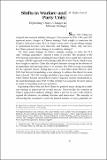Shifts in Warfare and Party Unity: Explaining China's Changes in Military Strategy
Author(s)
Fravel, Maris Taylor
Downloadisec_a_00304.pdf (176.0Kb)
PUBLISHER_POLICY
Publisher Policy
Article is made available in accordance with the publisher's policy and may be subject to US copyright law. Please refer to the publisher's site for terms of use.
Terms of use
Metadata
Show full item recordAbstract
Since 1949, China has adopted nine national military strategies, known as “strategic guidelines.” The strategies adopted in 1956, 1980, and 1993 represent major changes in China's military strategy, or efforts by the People's Liberation Army (PLA) to wage war in a new way. Shifts in the conduct of warfare in the international system offer one explanation for why China, a developing country for most of this period, pursued major change in its military strategy. Such shifts in the conduct of warfare should be especially powerful if a gap exists between a state's current strategy and the requirements of future warfare. The PLA has only been able to change strategy, however, when the Chinese Communist Party leadership is united and agrees on basic policies and the structure of authority. When the party is united, it delegates substantial responsibility for military affairs to the PLA leadership, which changes or adjusts military strategy in response to changes in China's security environment.
Date issued
2018-01Department
Massachusetts Institute of Technology. Department of Political ScienceJournal
International Security
Publisher
MIT Press - Journals
Citation
Fravel, M. Taylor. “Shifts in Warfare and Party Unity: Explaining China’s Changes in Military Strategy.” International Security 42, no. 3 (January 2018): 37–83.
Version: Final published version
ISSN
0162-2889
1531-4804